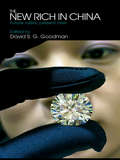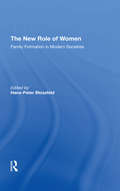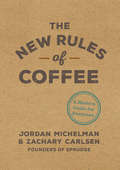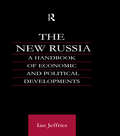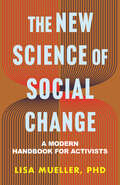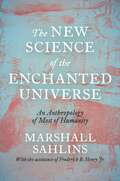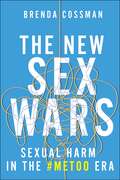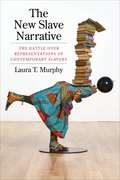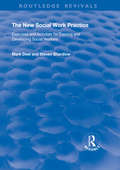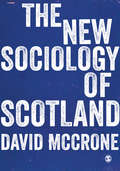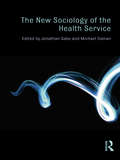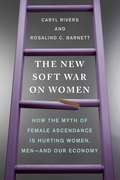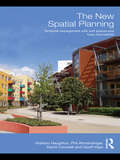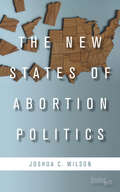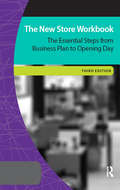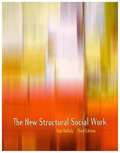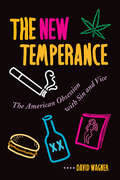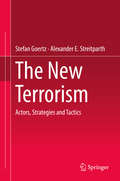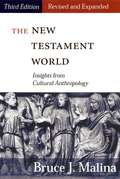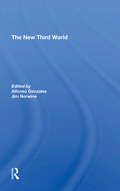- Table View
- List View
The New Rich in China: Future rulers, present lives
by David S. G. GoodmanThree decades of reform since 1978 in the People’s Republic of China have resulted in the emergence of new social groups which have included new occupations and professions generated as the economy has opened up and developed and, most spectacularly given the legacy of state socialism, the identification of those who are regarded as wealthy. However, although China’s new rich are certainly a consequence of globalization, there remains a need for caution in assuming either that China’s new rich are a middle class, or that if they are they should immediately be equated with a universal middle class. Including sections on class, status and power, agency and structure and lifestyle The New Rich in China investigates the political, socio-economic and cultural characteristics of the emergent new rich in China, the similarities and differences to similar phenomenon elsewhere and the consequences of the new rich for China itself. In doing so it links the importance of China to the world economy and helps us understand how the growth of China’s new rich may influence our understanding of social change elsewhere. This is a subject that will become increasingly important as China continues its development and private entrepreneurship continues to be encouraged and as such The New Rich in China will be an invaluable volume for students and scholars of Chinese studies, history and politics and social change.
The New Right in the New Europe: Czech Transformation and Right-Wing Politics, 1989–2006 (BASEES/Routledge Series on Russian and East European Studies)
by Seán HanleyThis book considers the emergence of centre right parties in Eastern Europe following the fall of communism, focusing primarily on the case of the Czech Republic. Although the country with the strongest social democratic traditions in Eastern Europe, the Czech Republic also produced the region’s strongest and most durable party of the free market right in Václav Klaus’ Civic Democratic Party (ODS). Seán Hanley considers the different varieties of right-wing politics that emerged in post-communist Europe, exploring in particular detail the origins of the Czech neo-liberal right, tracing its genesis to the reactions of dissidents and technocrats to the collapse of 1960s reform communism. He argues that, rather than being shaped by distant historical legacies, the emergence of centre-right parties can best be understood by examining the responses of counter-elites, outside or marginal to the former communist party-state establishment, to the collapse of communism and the imperatives of market reform and decommunization. This volume goes on to consider the emergence of right-wing forces in the disintegrating Civic Forum movement in 1990, the foundation of the ODS, the right’s period in office under Klaus in 1992-97, and its subsequent divisions and decline. It concludes by analyzing the ideology of the Czech Right, and its growing euroscepticism.
The New Role Of Women: Family Formation In Modern Societies
by Hans-peter Blossfeld Kathleen KiernanThis is the first book to systematically track postwar changes in family formation in Western Europe and the United States. Cohabitation and motherhood outside of marriage have become more widespread at the same time that women’s social roles are evolving. Women are attaining higher levels of education, marrying at an older age, more frequently working outside the home, and have more reproductive freedom due to new advances in contraception. In this original collection of essays, sociologists and demographers from eight Western European countries and the United States use longitudinal data to compare national variations and explain the connection between the new role of women and family formation in postwar society. The contributors provide a thorough review of the social demographic literature to advance a variety of hypotheses about the relationships between changing women’s education and family formation outcomes, which are empirically examined and compared across countries.
The New Routledge Companion to Science Fiction (Routledge Literature Companions)
by Mark Bould Sherryl Vint Andrew M. ButlerThe New Routledge Companion to Science Fiction provides an overview of the study of science fiction across multiple academic fields. It offers a new conceptualisation of the field today, marking the significant changes that have taken place in sf studies over the past 15 years.Building on the pioneering research in the first edition, the collection reorganises historical coverage of the genre to emphasise new geographical areas of cultural production and the growing importance of media beyond print. It also updates and expands the range of frameworks that are relevant to the study of science fiction. The periodisation has been reframed to include new chapters focusing on science fiction produced outside the Anglophone context, including South Asian, Latin American, Chinese and African diasporic science fiction. The contributors use both well- established critical and theoretical approaches and embrace a range of new ones, including biopolitics, climate crisis, critical ethnic studies, disability studies, energy humanities, game studies, medical humanities, new materialisms and sonic studies. This book is an invaluable resource for students and established scholars seeking to understand the vast range of engagements with science fiction in scholarship today.
The New Rules of Coffee: A Modern Guide for Everyone
by Jordan Michelman Zachary CarlsenAn illustrated guide to the essential rules for enjoying coffee both at home and in cafes, including tips on storing and serving coffee, coffee growing, roasting and brewing, plus facts, lore, and popular culture from around the globe.This introduction to all things coffee written by the founders and editors of Sprudge, the premier website for coffee content, features a series of digestible rules accompanied by whimsical illustrations. Divided into three sections (At Home, At the Cafe, and Around the World), The New Rules of Coffee covers the basics of brewing and storage, cafe etiquette and tips for enjoying your visit, as well as essential information about coffee production (What is washed coffee?), coffee myths (Darker is not stronger!), and broadcasts from a new international coffee culture.
The New Russia: A Handbook of Economic and Political Developments
by Ian JeffriesThe rapid changes in Russia since the collapse of the Soviet Union are often bewildering, with many frequent, highly significant changes in the different sectors of the economy and the political system. There have been frequent changes of personnel in government and economic management and many changes have been reversed - and sometimes forgotten, or at other times reinstated. What happened when? Who was responsible for what? Did such a change in one sector precede or follow a particular change elsewhere? These are points not easily remembered. This book provides full details of the many changes, and enables sense to be made of what would otherwise be a confusing situation. Developments are arranged chronologically by sector, and the book is unusual in extensively chronicling both economic and political developments and the crucial connections between them. There is a generous introduction and overview to help the reader find his or her way around. The material covers the period up to late autumn 2000, and thus offers a valuable guide to policies in the Putin era.
The New Science of Ageing (The New Dynamics of Ageing)
by Alan WalkerThis unique book represents the first multi-disciplinary examination of ageing, covering everything from basic cell biology, to social participation in later life, to the representations of old age in the arts and literature. A comprehensive introductory text about the latest scientific evidence on ageing, the book draws on the pioneering New Dynamics of Ageing Programme, the UK’s largest research programme in ageing. This programme brought together leading academics from across the arts and humanities, social and biological sciences and fields of engineering and medical research, to study how ageing is changing and the ways in which this process can be made more beneficial to both individuals and society. Comprising individual, local, national and global perspectives, this book will appeal to everyone with an interest in one of the greatest challenges facing the world – our own ageing.
The New Science of Social Change: A Modern Handbook for Activists
by Lisa MuellerIn this accessible guide for activists, scholar Lisa Mueller translates cutting-edge empirical research on effective protest to show how to make movements really matterWe are in the middle of a historic swell of activism taking place throughout the world. From Occupy Wall Street and the Arab Spring, to pro-democracy uprisings in China, Black Lives Matter, the Women&’s March on Washington, and more recent pro-choice protests; folks everywhere are gathering to demand a more just world. Yet despite social engagement being at record highs, there is a divide between the activist community and the scientists—like Lisa Mueller, PhD—who study it.In The New Science of Social Change, Mueller highlights what really works when it comes to group advocacy, to place proven tools in the hands of activists on the ground—in the U.S. and abroad. Drawing on both her decade-long career researching the science of protest and the work of other scholars, she stresses such things as the ingredients of collective action and how protests with cohesive demands are significantly more likely to win concessions than protests with mixed demands. Incorporating interactive exercises and the voices of experienced activists with her analysis, Mueller shows how a working knowledge of social science can help activists implement more effective strategies to create the real-world changes we want to see.
The New Science of the Enchanted Universe: An Anthropology of Most of Humanity
by Marshall SahlinsOne of the world’s preeminent cultural anthropologists leaves a last work that fundamentally reconfigures how we study most other culturesFrom the perspective of Western modernity, humanity inhabits a disenchanted cosmos. Gods, spirits, and ancestors have left us for a transcendent beyond, no longer living in our midst and being involved in all matters of everyday life from the trivial to the dire. Yet the vast majority of cultures throughout human history treat spirits as very real persons, members of a cosmic society who interact with humans and control their fate. In most cultures, even today, people are but a small part of an enchanted universe misconstrued by the transcendent categories of “religion” and the “supernatural.” The New Science of the Enchanted Universe shows how anthropologists and other social scientists must rethink these cultures of immanence and study them by their own lights.In this, his last, revelatory book, Marshall Sahlins announces a new method and sets an exciting agenda for the field. He takes readers around the world, from Inuit of the Arctic Circle to pastoral Dinka of East Africa, from Araweté swidden gardeners of Amazonia to Trobriand Island horticulturalists. In the process, Sahlins sheds new light on classical and contemporary ethnographies that describe these cultures of immanence and reveals how even the apparently mundane, all-too-human spheres of “economics” and “politics” emerge as people negotiate with, and ultimately usurp, the powers of the gods.The New Science of the Enchanted Universe offers a road map for a new practice of anthropology that takes seriously the enchanted universe and its transformations from ancient Mesopotamia to contemporary America.
The New Sex Wars: Sexual Harm in the #MeToo Era
by Brenda CossmanRevisits the sex wars of the 1970s and ’80s and examines their influence on how we think about sexual harm in the #MeToo era#MeToo’s stunning explosion on social media in October 2017 radically changed—and amplified—conversations about sexual violence as it revealed how widespread the issue is and toppled prominent celebrities and politicians. But, as the movement spread, a conflict emerged among feminist supporters and detractors about how punishment should be doled out and how justice should be served. The New Sex Wars reveals that these clashes are nothing new. Delving into the contentious debates from the ’70s and ‘80s, Brenda Cossman traces the striking echoes in the feminist divisions of this earlier period. In exploring the history of past conflicts—the resistance to finding common ground, the media’s pleasure in portraying the debates as polarized cat fights, the simplification of viewpoints as pro- and anti-sex—she shows how they have come to shape the #MeToo era. From the ’70s to today, Cossman examines tensions between the need for recognition and protection under the law, and the colossal and ongoing failure of that law to redress historic injustice. By circumventing law altogether, #MeToo has led us to question whether justice can be served outside of the courtroom. Cossman argues for a different way forward—one based on reparative models that focus on shared desired outcomes and the willingness to understand the other side. Thoughtful and compelling, The New Sex Wars explores what can been learned from these stories, what traps we repeatedly fall into, how we have been denied our anger, and where to begin to make law work.
The New Slave Narrative: The Battle Over Representations of Contemporary Slavery
by Laura MurphyA century and a half after the abolition of slavery in the United States, survivors of contemporary forms of enslavement from around the world have revived a powerful tool of the abolitionist movement: first-person narratives of slavery and freedom. Just as Frederick Douglass, Harriet Jacobs, and others used autobiographical testimonies in the fight to eradicate slavery, today’s new slave narrators play a crucial role in shaping an antislavery agenda. Their writings unveil the systemic underpinnings of global slavery while critiquing the precarity of their hard-fought freedom. At the same time, the demands of antislavery organizations, religious groups, and book publishers circumscribe the voices of the enslaved, coopting their narratives in support of alternative agendas.In this pathbreaking interdisciplinary study, Laura T. Murphy argues that the slave narrative has reemerged as a twenty-first-century genre that has gained new currency in the context of the memoir boom, post-9/11 anti-Islamic sentiment, and conservative family-values politics. She analyzes a diverse range of dozens of book-length accounts of modern slavery from Africa, Asia, the United States, the United Kingdom, and Europe, examining the narrative strategies that survivors of slavery employ to make their experiences legible and to promote a reinvigorated antislavery agenda. By putting these stories into conversation with one another, The New Slave Narrative reveals an emergent survivor-centered counterdiscourse of collaboration and systemic change that offers an urgent critique of the systems that maintain contemporary slavery, as well as of the human rights industry and the antislavery movement.
The New Social Division: Making and Unmaking Precariousness (Palgrave Studies in European Political Sociology)
by Donatella Della Porta Tiina Silvasti Sakari Hänninen Martti SiisiäinenThis volume addresses issues of precariousness in a broad, interdisciplinary perspective, looking at socio-economic transformations as well as the identity formation and political organizing of precarious people. The collection bridges empirical research with social theory to problematize and analyse the precariat.
The New Social Work Practice: Exercises and Activities for Training and Developing Social Workers (Routledge Revivals)
by Mark Doel Steven ShardlowFirst published in 1998, this book is a fully revised and updated edition of Social Work Practice, first published in 1993 as a training manual. The New Social Work Practice presents a comprehensive view of contemporary social work. Whether it be general or specialist practice, care and control or power and oppression, these central issues and recurring themes are given a topical treatment. Changes in core aspects of social work are fully explored in lively and realistic ways, combining the essence of good practice with current organizational demands. The aim of the original workbook remains intact: to guide and stimulate learning about social work practice. The book achieves this purpose by presenting various aspects of social work using different settings and contexts. New and revised activities are included to promote discussion, understanding, learning and better practice. Taken toether, the topics and themes in the book define the essential elements of a curriculum for social work practice.
The New Sociology of Scotland
by David McCroneWritten by a leading sociologist of Scotland, this ground-breaking new introduction is a comprehensive account of the social, political, economic and cultural processes at work in contemporary Scottish society. At a time of major uncertainty and transformation The New Sociology of Scotland explores every aspect of Scottish life. Placed firmly in the context of globalisation, the text: examines a broad range of topics including race and ethnicity, social inequality, national identity, health, class, education, sport, media and culture, among many others. looks at the ramifications of recent political events such as British General Election of 2015, the Scottish parliament election of May 2016, and the Brexit referendum of June 2016. uses learning features such as further reading and discussion questions to stimulate students to engage critically with issues raised. Written in a lucid and accessible style, The New Sociology of Scotland is an indispensable guide for students of sociology and politics.
The New Sociology of Scotland
by Professor David McCroneWritten by a leading sociologist of Scotland, this ground-breaking new introduction is a comprehensive account of the social, political, economic and cultural processes at work in contemporary Scottish society. At a time of major uncertainty and transformation The New Sociology of Scotland explores every aspect of Scottish life. Placed firmly in the context of globalisation, the text: examines a broad range of topics including race and ethnicity, social inequality, national identity, health, class, education, sport, media and culture, among many others. looks at the ramifications of recent political events such as British General Election of 2015, the Scottish parliament election of May 2016, and the Brexit referendum of June 2016. uses learning features such as further reading and discussion questions to stimulate students to engage critically with issues raised. Written in a lucid and accessible style, The New Sociology of Scotland is an indispensable guide for students of sociology and politics.
The New Sociology of the Health Service
by Jonathan Gabe Michael CalnanHealth service policy and health policy have changed considerably over the past fifteen years and there is a pressing need for an up-to-date sociological analysis of health policy. Not only have policies themselves changed but new policy themes – such as evidence-based policy and practice, an increasing focus on a primary care led health service, a growing recognition of the need to address inequalities through public health policies and a focus on the views and the voice of the user and the public– have emerged alongside some of the old. Following up the very successful The Sociology of the Health Service, this all-new volume covers a broad range of key contemporary health services issues. It includes chapters on consumerism, technology, evidence-based practice, public health, managerialism and social care among others, and incorporates references to new developments, such as regulation and incentivization, throughout. The New Sociology of the Health Service provides a vital new sociological framework for analyzing health policy and healthcare. It is an important read for all students and researchers of medical sociology and health policy.
The New Soft War on Women
by Caryl RiversFor the first time in history, women make up half the educated labor force and are earning the majority of advanced degrees. It should be the best time ever for women, and yet. . . it’s not. Storm clouds are gathering, and the worst thing is that most women don’t have a clue what could be coming. In large part this is because the message they’re being fed is that they now have it made. But do they? In The New Soft War on Women, respected experts on gender issues and the psychology of women Caryl Rivers and Rosalind C. Barnett argue that an insidious war of subtle biases and barriers is being waged that continues to marginalize women. Although women have made huge strides in recent years, these gains have not translated into money and influence. Consider the following: - Women with MBAs earn, on average, $4,600 less than their male counterparts in their first job out of business school. - Female physicians earn, on average, 39 percent less than male physicians. - Female financial analysts take in 35 percent less, and female chief executives one quarter less than men in similar positions. In this eye-opening book, Rivers and Barnett offer women the real facts as well as tools for combating the "soft war” tactics that prevent them from advancing in their careers. With women now central to the economy, determining to a large degree whether it thrives or stagnates, this is one war no one can afford for them to lose. .
The New Spatial Planning: Territorial Management with Soft Spaces and Fuzzy Boundaries
by Philip Allmendinger Geoff Vigar Graham Haughton David CounsellSpatial planning, strongly advocated by government and the profession, is intended to be more holistic, more strategic, more inclusive, more integrative and more attuned to sustainable development than previous approaches. In what the authors refer to as the New Spatial Planning, there is a fairly rapidly evolving maturity and sophistication in how strategies are developed and produced. Crucially, the authors argue that the reworked boundaries of spatial planning means that to understand it we need to look as much outside the formal system of practices of ‘planning’ as within it. Using a rich empirical resource base, this book takes a critical look at recent practices to see whether the new spatial planning is having the kinds of impacts its advocates would wish. Contributing to theoretical debates in planning, state restructuring and governance, it also outlines and critiques the contemporary practice of spatial planning. This book will have a place on the shelves of researchers and students interested in urban/regional studies, politics and planning studies.
The New States of Abortion Politics
by Joshua WilsonThe 2014 Supreme Court ruling on McCullen v. Coakley striking down a Massachusetts law regulating anti-abortion activism marked the reengagement of the Supreme Court in abortion politics. A throwback to the days of clinic-front protests, the decision seemed a means to reinvigorate the old street politics of abortion. The Court's ruling also highlights the success of a decades' long effort by anti-abortion activists to transform the very politics of abortion. The New States of Abortion Politics, written by leading scholar Joshua C. Wilson, tells the story of this movement, from streets to legislative halls to courtrooms. With the end of clinic-front activism, lawyers and politicians took on the fight. Anti-abortion activists moved away from a doomed frontal assault on Roe v. Wade and adopted an incremental strategy--putting anti-abortion causes on the offensive in friendly state forums and placing reproductive rights advocates on the defense in the courts. The Supreme Court ruling on Whole Woman's Health v. Hellerstedt in 2016 makes the stakes for abortion politics higher than ever. This book elucidates how--and why.
The New Store Workbook: The Essential Steps from Business Plan to Opening Day (Museum Store Association #2)
by Museum Store AssociationThe New Store Workbook gets down to the nitty gritty of planning to open a new museum store, from calculating the sales dollars needed per square foot, to estimating dollars spent by visitors, all the way to moving the whole operation onto the right e-commerce platform. The thirteen chapters that make up this journey are peppered with charts, tables, and real-world examples, including inventory projections, purchase orders, job announcements, and press releases. The new edition expands the discussion on social media, mobile shopping and new platforms for e-commerce and includes a complete chapter dedicated to the ins and outs of the Unrelated Business Income Tax. It’s your personal assistant, helping you embark on a successful adventure straight through opening day.
The New Structural Social Work: Ideology, Theory, Practice
by Bob MullalyThe New Structural Social Work reveals the shortcomings of conventional social work, which accepts and participates in the present social order rather than addressing the systemic social problems that exist within capitalist societies. Mullaly advocates for a progressive view of social work that is practiced within the social agency, outside of the agency, and within the personal lives of structural social workers.
The New Temperance: The American Obsession With Sin And Vice
by David WagnerThe war on drugs ... the campaigns against smoking cigarettes ... v-chips to control what children watch on TV ... censoring the Internet and Calvin Klein jeans ads...bipartisan lectures about the dangers of teen sex ... constant warnings about food and fat ... all are examples of what David Wagner terms the "New Temperance." The New Temperance contrasts the new obsession with personal behavior in America during the last two decades with the brief period of relative freedom in the 1960s and early 1970s and suggests strong consistencies with our past. In particular, the late twentieth century appears to have re-created the mood of the Victorian and Progressive Periods, when social movements such as the Temperance, Social Purity, and Vice and Vigilance movements held sway. The New Temperance questions the constant mantra in the media and in political debates about the dangers of personal behavior and challenges America's love affair with repression.
The New Terrorism: Actors, Strategies and Tactics
by Stefan Goertz Alexander E. StreitparthIn light of asymmetrical security threats in western democracies as well as in conflict regions, this timely book examines the actors, strategies and tactics of Islamist terrorism and transnational organized crime around the globe. The authors develop an interdisciplinary approach to understanding the ideologies, forms of cooperation, and technological means used in new forms of terrorism. The book starts with an empirical analysis of the new Jihadism as a global Islamist theology and strategy. Furthermore, it investigates the interaction, cooperation and fusion of transnational organized crime and Islamist terrorism and highlights new communication technologies as vital tools for terrorism. Lastly, the book provides an analysis of asymmetrical strategies and tactics used by terrorist organisations, and of low-level terrorism. As such, it will appeal to all political scientists and criminologists studying terrorism, as well as to professionals at various national and international security services.
The New Testament World: Insights from Cultural Anthropology (Third Edition, Revised and Expanded)
by Bruce J. MalinaA classroom standard for two decades,The New Testament World: Insights from Cultural Anthropology has introduced students to both the New Testament and the social-scientific study of the New Testament. This revised and expanded third edition offers new chapters on envy and the Jesus movement, updates chapters from earlier editions, augments the bibliography, and offers student study questions.
The New Third World: Second Edition
by Jim Norwine Alfonzo GonzalezThis book characterizes the Third World at the close of the twentieth century. It provides an excellent interdisciplinary exploration of the meanings, measures, patterns, and problems associated with the concept of the Third World.
